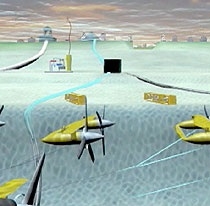US Researchers Hope to Tap Ocean Flows for Electricity
The same energy that drives ocean waves and currents may be a rich source of electrical power. Researchers in Florida say even gentle flows of two or three knots are enough to drive a propeller attached to an underwater turbine. Advocates say ocean power could be cheap and help replace oil or coal-based systems that are blamed for global warming.
"It is a lot more challenging to put something in
the ocean, and certainly any energy system to go in there has to work and be
competitive with existing land-based technologies."
-- Rick Driscoll, Head of Center for Ocean Energy Technology, Florida
Atlantic University
The goal is to harness the energy produced by the rise and fall of waters during the tidal cycle. His group is working on a test turbine that it plans to submerge in a site about nine meters under water between two islands.
"By the end of 2008 or early 2009, we will have several [turbines] just to see how we can manage them as a group. Then another year after, it will be several hundred," Bedgood said.
The first step, however, is to show authorities that the groundbreaking project will not damage wildlife or coastal resources in the popular tourist area. Bedgood says marine life should be unharmed. "For manatees and turtles, our turbines will be mounted up off the [ocean] floor, so they can maneuver through them. And the leading edges of any moving part will have foam rubber cushions on them," he explains.
Renewable energy projects like this one aim to reduce existing strains on the earth's resources, but they do raise concern about causing new problems. Kenny Broad is a professor at the Rosenstiel School for Marine and Atmospheric Science near Miami. He says new initiatives should proceed with caution.
"Take small steps at first, try to favor things that are reversible, as opposed to just going for it," recommends Broad. "We are all attracted to clean technologies, and we need to develop and promote clean technologies, but in a responsible way."
Similar projects are planned in Europe and other U.S. cities. Just 300 kilometers from Key West, researchers at Florida Atlantic University want to tap the powerful Gulf Stream current that brings warm water north into the Atlantic Ocean.
"So it is a significant velocity with the equivalent energy of some of the world's richest energy sites," says Rick Driscoll, who is head of the university's Center for Ocean Energy Technology. He says one of the biggest challenges is developing equipment that can withstand the intense forces of the current. "It is a lot more challenging to put something in the ocean, and certainly any energy system to go in there has to work and be competitive with existing land-based technologies," notes Driscoll.

Illustration of a massive ocean turbine farm
He says more investment is needed for new technologies. "There is a lot of significant potential, but there is a limited supply of money out there right now," he adds.
Driscoll says federal and state funding could help U.S. researchers perfect the new technologies and bring the benefits to other countries around the world.
Reprinted from Voice of America, a multimedia international broadcasting service funded by the U.S. government through the Broadcasting Board of Governors. VOA broadcasts more than 1,000 hours of news, information, educational, and cultural programming every week to an estimated worldwide audience of more than 115 million people.